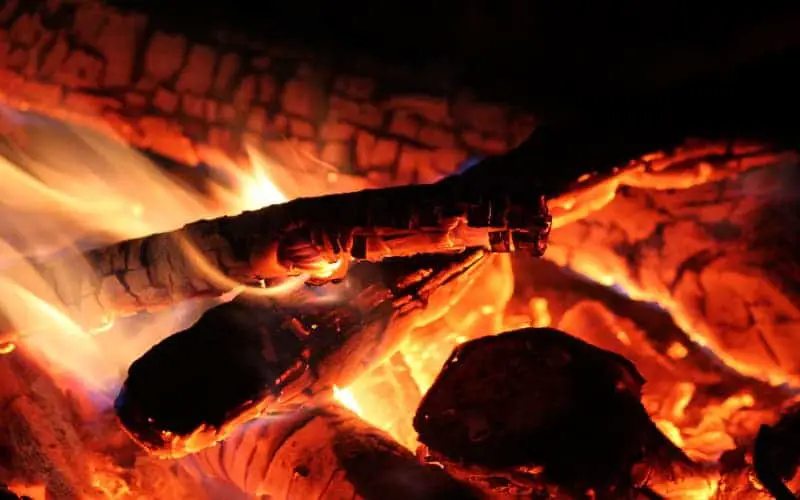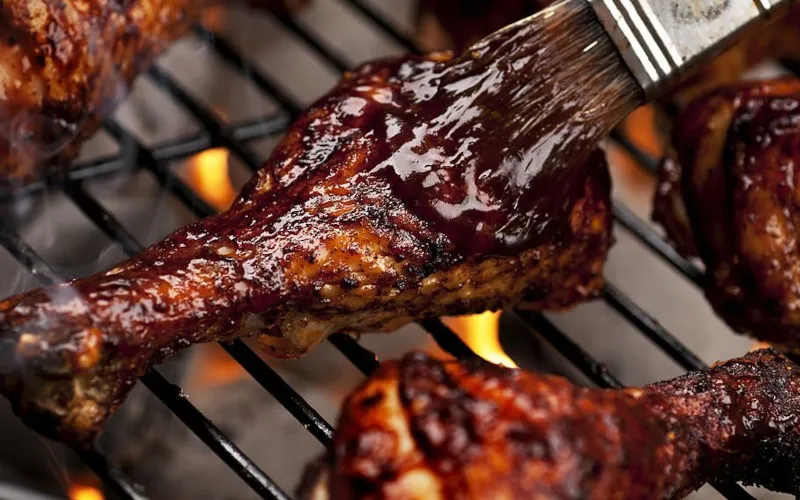If you’re looking to cook brisket, you may have come across the term probe. This refers to using an internal meat thermometer to ensure that your brisket has reached the perfect temperature during cooking. Probing ensures that you achieve the ultimate tenderness and juiciness, which can only be achieved when you cook meat at the right temperature for the right amount of time.
This guide will show you where to probe brisket so that you get the most accurate reading of its temperature—so that when it’s done, it’s done!
Where to Check Brisket Temperature?
The ideal place to check for doneness is at a natural seam in your brisket.
There are three natural seams on a brisket:
- Between the point and flat
- Between each of those sections
- Along one side of each section.
So which of the three is best? The area between the point and flat may contain more meat on the flat side but may not be the best for probing because it’s so close to the fat from the point. The difference in content between the two places may result in unstable readings (or a large variation).
The same goes for inserting a probe along one side of each section; there’s not enough meat there to provide accurate readings. That leaves us with probing between each section, the flat and the point.
The point has a fat content and connective tissue, thus making it tougher—and hotter than other parts of your brisket. That means inserting a probe there would give you an incorrect reading about how done your meat is.
Our final option is the flat. It’s best to use that seam as your guide because it contains most of your brisket and gives you an accurate reading. Once you insert your probe into that seam, check its temperature periodically until it reaches 185 degrees Fahrenheit (if this is your desired temperature).
If you find yourself unable to get an instant-read thermometer into that seam, make sure it doesn’t touch any fat or connective tissue—you want to avoid getting any trash reading on your thermometer—and press down firmly to the densest part so that it touches as much meat as possible.
Do You Probe A Brisket In The Flat Or Point?
To properly cook a brisket, you need to know how to probe it properly. Where do you probe? If you think that all you have to do is pop a thermometer into any part of your brisket and wait for it to reach a specific temperature, then you are sadly mistaken.
Because of its odd shape, there are many places on a brisket where you can insert your thermometer to get an accurate reading. But which one is right?
As we’ve seen above, it’s recommended to probe your brisket in the flat. The flat is where you get all of your smoke flavors, and it is where you want to test for doneness. The point is much fatter and will be more prone to drying out if overcooked (or undercooked) thus giving false readings.
You might choose to use a thermometer in the point, but that’s not common practice among most pitmasters. So, remember: probe in the flat and check the temperature on the flat!
What Tools Do You Need to Probe a Brisket?
There are two types of thermometers you can use to check for doneness. The first is an instant-read thermometer, which will register a temperature immediately upon insertion into your brisket. This is fine if you’re checking temperatures every 10 or 15 minutes and want to see if it’s time to wrap your brisket, as it doesn’t have to remain in place once you take a reading.
The second type of thermometer is a probe thermometer that allows you to monitor internal meat temperatures over several hours without removing them from their position. A good probe thermometer should withstand high heat (up to 500 degrees Fahrenheit) and should come with several probes so that you can monitor multiple pieces of meat at once.
There are two types of probe thermometers: wired and wireless. Wired units connect directly to your smoker’s temperature controller, while wireless units transmit data through radio waves or infrared light.
Wireless models tend to be more expensive than wired ones, but they allow you greater freedom because they don’t require direct access to your smoker’s temperature controller.
How Do You Clean a Temperature Probe?
Ideally, your probe should be sanitized between uses. Cleaning a probe requires removing it from whatever it’s being used for, so wait until before you put it away to clean it.
The cleaning process involves a few simple steps:
- Soak in warm water: Soaking the temperature probe in warm water for a few minutes will remove most of it.
- Clean with soap and brush or scouring pad: Use a mild soap, like dishwashing liquid, to scrub away anything remaining. You can also use a toothbrush to get into tight spots or a scouring pad for tough buildup. Rinse thoroughly under running water.
- Sanitize with alcohol or vinegar solution: You can sanitize your probe by submerging it in a solution of 1 part alcohol to 9 parts water for 10 minutes or by soaking it in a solution of 1 part vinegar to 4 parts water for 5 minutes.
- Rinse thoroughly under running water: Rinsing allows the traces of alcohol/vinegar to wash away.
- Dry with a clean towel or let air dry: Use a clean towel to dry your thermometer probe. Alternatively, you could air dry it. If you’re using your probe again right away, you can skip steps 2 and 3; rinse with warm water, rinse, and allow to air dry before using again.
- Store the probe in a clean, dry place: Store your probe in a clean, dry place when you’re not using it. If you need to store it for an extended period, wrap it in aluminum foil and put it in a freezer bag to protect against moisture and keep out bugs.
Where To Put Traeger Probe In A Brisket?
Traeger grills are designed to cook with indirect heat. This means that you need to know where to put your probe in a brisket so as not to touch any part of your grill or smoker. If you don’t know where to put your probe, you could end up with burnt meat and a ruined brisket.
Related: How to Get Bark on Brisket
The best place to put your Traeger probes is on or right above the flat. The flat can be anywhere from 1/4′′ – 1′′ thick, depending on how fatty or lean your brisket is. Putting the probe at about ½” deep would provide accurate results.
For most briskets, you will want to stick one probe in the center of the flat. This way, you get an accurate reading for internal temperature and don’t run into any problems with uneven cooking if there is more meat on one side than another.
The most important thing is to make sure that your meat is cooked indirectly by keeping it away from direct flames or heating elements. If you are cooking a brisket, you will want to put a drip pan between your meat and any heat source. This will help keep moisture in and prevent flare-ups.
If you don’t have a drip pan, you can use aluminum foil to cover up any exposed areas of grill grates where there might be gaps between them.
Where Does the Temperature Probe Go in a Smoker?
People’s most common mistake when smoking brisket is they fail to put the temperature probe in the right place. Like in other cooking equipment, the temperature probe in a smoker should always go to the deepest part of the meat and not touch bone or fat. This will ensure that you get an accurate reading of how well your brisket is cooking and how long it will take until it’s ready to be served.
The one exception to where you put your temperature probe in a smoker is if you are using a charcoal grill. In that case, you’ll want to insert it at an angle instead of straight into your meat.
The reason for doing so is to prevent your probe from getting clogged with ash. If left uncleaned, an obstruction like ash can cause your temperature gauge to give inaccurate readings as more of its heat builds up rather than being conducted into your food. That could result in undercooked or overcooked food.
Placing your probe at an angle will also ensure that it remains out of contact with any direct flames, damaging them and rendering them useless until they are replaced.
It’s important to note that while probes explicitly designed for smokers work best, they aren’t required; any long-stemmed digital thermometer will do just fine but keep in mind where you need to place it when buying your cooking equipment.
Frequently Asked Questions
What Cut of Beef is the Brisket?
The brisket is a cut of beef from an animal’s breast or lower chest. One of three primal cuts (the others are chuck and rib) makes up a whole steer or heifer. The brisket muscles do most of their work pushing food down, so they tend to be very tough, with lots of connective tissue. This makes them ideal for long, slow cooking—which is why they are often used in barbecue recipes.
Most cuts of brisket can be prepared by braising, stewing, pot roasting, or barbecuing. Barbecuing involves low-temperature smoking over several hours with indirect heat applied via a drip pan filled with water below the meat. Brisket may also be used as a ground meat ingredient in tacos, burritos, enchiladas, and chili dishes.
What Is The Best Way To Shop For Brisket?
When you’re buying a brisket, look for the deep red one. Avoid pieces with a large amount of white fat. If possible, buy your brisket from a butcher or specialty meat shop where it has been properly aged. This process allows enzymes to break down tough connective tissue and improves flavor and tenderness.
If you can’t find an aged piece of brisket, ask your butcher to cut off any excess fat and trim lean—which means he will remove as much fat as possible without compromising overall quality or appearance. If you can smell it or its packaging is torn or dirty, pass on it—it’s probably been sitting too long and won’t be as fresh as you need it to be for your recipe.
All meat should feel firm and spring back when pressed; avoid soft or wet-feeling packages.
What Is The Best Way To Store Brisket?
Once you’ve got your brisket home, store it in a resealable plastic bag and keep it in your refrigerator for up to five days. If you aren’t planning on cooking it within that time, freeze it for up to three months.
Place it inside a sealable freezer bag or wrap it tightly with foil when storing frozen meat. This will prevent it from picking up other odors and help maintain its quality.
How Do You Know When Your Brisket Is Done?
There are two ways to know if your brisket is done—by temperature and by feel. Use a meat thermometer (preferably one with a digital readout) to test for doneness. According to USDA guidelines, a well-done brisket should be cooked until it reaches an internal temperature of 190 degrees Fahrenheit.
For medium-rare, cook it until it reaches 170 degrees Fahrenheit; for medium, cook it until it reaches 180 degrees Fahrenheit; and for well-done, cook it until it reaches 190 degrees Fahrenheit. When testing by the feel, you’ll want to press on both ends of your brisket with tongs or chopsticks.
If you can quickly press through, it’s not ready yet. It might be overdone if you can’t press through at all.
Conclusion
A specific place is most suitable for checking brisket temperature. It’s on the thickest part of the flat. The meat should be 190 degrees Fahrenheit when ready to come off the grill. Be sure to use an instant-read thermometer and not a traditional thermometer.
You can also use an electric probe thermometer, which will help you monitor your food without opening up your smoker or grill too often. Remember: Don’t forget to rest your meat before you can serve it!





